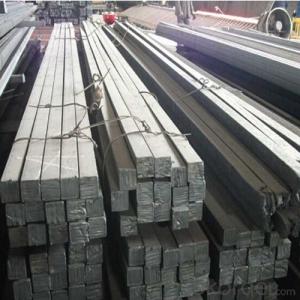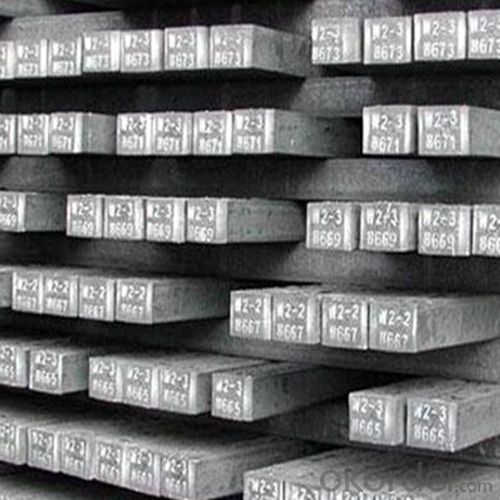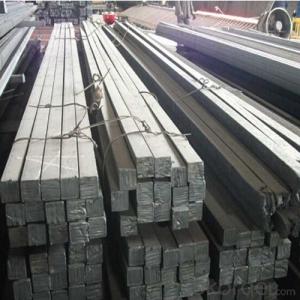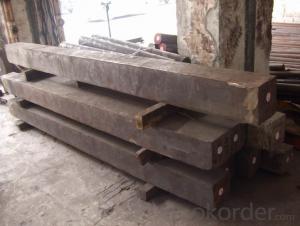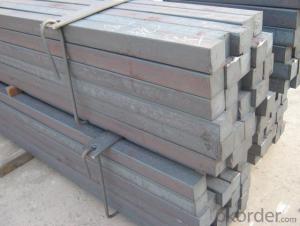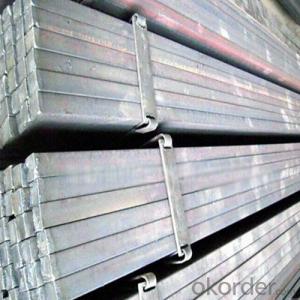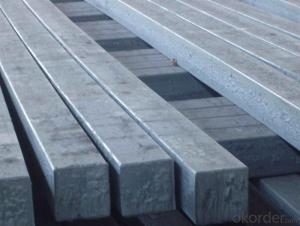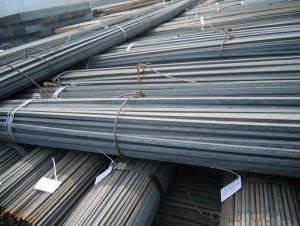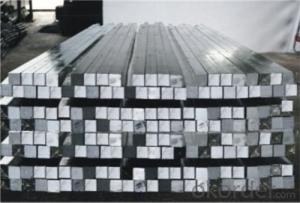Mild Steel Square Billet Bar for Rebar Production
- Loading Port:
- Tianjin
- Payment Terms:
- TT OR LC
- Min Order Qty:
- 25 m.t.
- Supply Capability:
- 1000 m.t./month
OKorder Service Pledge
OKorder Financial Service
You Might Also Like
1. Structure of Mild Steel Square Billet Bar for Rebar Production Description:
Mild steel square billet bar for rebar production is a bar with square shaped cross-section. It is special case of equal sides. Before steel products are sold on the market, the steel must first be processed into more functional pieces. Raw steel cannot be of use while in its pure form, thus it has to be cast into shape. The freshly made steel, mild steel square billet bar for rebar production is still in the form of a metal bar or rectangle. Small sizes of mild steel square billet bar for rebar production are used in ship building.
2. Main Features of Mild Steel Square Billet Bar for Rebar Production:
• Grade: Q235
• Type: Mild carbon steel
• A quadrilateral with four equal sides and four right angles.
• Vibration: The stiffness and mass are chosen to prevent unacceptable vibrations, particularly in settings sensitive to vibrations, such as offices and libraries.
• Local yield: Caused by concentrated loads, such as at the beam's point of support.
3. Mild Steel Square Billet Bar for Rebar Production Images:
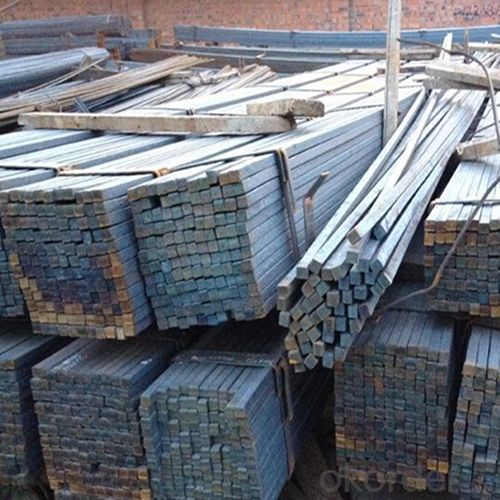

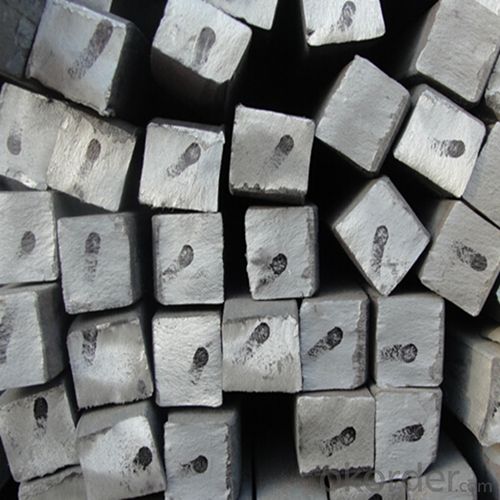
4. Mild Steel Square Billet Bar for Rebar Production Specification:
Mechanical Properties | Grade | Steel diameter(mm) | |||
≤16 | 16~40 | 40~60 | 60~100 | ||
Yield Point Δs/MPa | Q195 | ≥195 | ≥185 | - | - |
Q235 | 235 | 225 | 215 | 205 | |
Tensile Strength | Q195 | 315~390 | |||
Q235 | 375~500 | ||||
Elongation δ5% | Q195 | ≥33 | ≥32 | - | - |
Q235 | 26 | 25 | 24 | 23 | |
5. FAQ
We have organized several common questions for our clients,may help you sincerely:
①What is the main material?
There are two types of Square Bar, one is hot rolled square bar and other one is cold drawn square bar. Our principal products is hot rolled square bar. We dedicate to products with material Q195 and Q235. We offer products with high quality and low price.
②How to inspect the quality?
We have a professional inspection group which belongs to our company. We resolutely put an end to unqualified products flowing into the market. At the same time, we will provide necessary follow-up service assurance.
③Is there any advantage about this kind of product?
Steel I beam bar IPE has a reduced capacity in the transverse direction, and is also inefficient in carrying torsion, for which hollow structural sections are often preferred.
- Q: Can a steel square be used for measuring the depth of a pond?
- No, a steel square cannot be used for measuring the depth of a pond.
- Q: Can a steel square be used for checking the alignment of drill press tables?
- Indeed, the alignment of drill press tables can be verified using a steel square. This versatile tool serves the purpose of measuring and checking right angles. To guarantee proper alignment, simply position the steel square against both the drill press table and the drill bit. This ensures that the table is perpendicular to the drill bit, resulting in accurate and precise hole drilling. Moreover, the steel square can also assess the squareness of the table itself, preventing any tilting or misalignment. In conclusion, the steel square proves to be a practical tool for confirming the alignment of drill press tables.
- Q: How do you use a steel square to measure and mark out mitered joints?
- To use a steel square to measure and mark out mitered joints, follow these steps: 1. Start by ensuring that your steel square is clean and free from any debris or rust. This will help ensure accurate measurements. 2. Place the steel square on the edge of the material you are working with, aligning one leg of the square with the edge. 3. Hold the steel square firmly against the material and make sure it is flat against the surface. This will help prevent any potential inaccuracies. 4. Next, rotate the steel square until the desired angle for the mitered joint is achieved. This is typically a 45-degree angle for most mitered joints, but it may vary depending on the project or design. 5. Once the steel square is in the correct position, use a pencil or marking knife to trace along the edge of the square's other leg. This will create a clear and accurate line to guide your cuts. 6. Repeat this process for each piece of material that requires a mitered joint, ensuring that the angles and measurements are consistent across all pieces. 7. After marking out the mitered joints, double-check your measurements and angles to ensure accuracy before proceeding with any cutting or joining of the materials. It's important to note that using a steel square to measure and mark mitered joints requires precision and attention to detail. Taking your time and double-checking your measurements will help ensure that your mitered joints fit together perfectly and create a clean, professional finish.
- Q: Can a steel square be used for roofing work?
- Yes, a steel square can be used for roofing work. A steel square, also known as a speed square or rafter square, is a versatile tool that is commonly used in roofing construction. It is designed to assist in making accurate measurements, marking angles, and squaring up roof rafters. The steel square has a triangular shape with various markings and measurements on its surface. It typically has a 90-degree angle, a 45-degree angle, and a range of other angle measurements that are useful for roof layout and framing. These angles help roofers determine the correct pitch, slope, and alignment of the roof. In addition to angle measurements, a steel square also includes measurements for common rafter lengths, hip and valley lengths, and other important dimensions used in roofing. This allows roofers to make precise calculations and cuts when installing rafters, trusses, and other roofing components. Furthermore, a steel square can be used as a straight edge for drawing straight lines and cutting roofing materials such as shingles or tiles. Its durable steel construction makes it a reliable and long-lasting tool that can withstand the rigors of roofing work. Overall, a steel square is a valuable tool for roofing work as it helps ensure accurate measurements, proper alignment, and precise cuts. It is a must-have tool for any professional roofer or DIY enthusiast looking to achieve quality results in their roofing projects.
- Q: Can a steel square be used for checking the squareness of a workbench top?
- A workbench top's squareness can be checked using a steel square. This particular tool, also referred to as a try square or framing square, possesses a right-angle shape which aids in determining the squareness and alignment of a workbench top. To conduct the check, one must position the steel square against the edges of the workbench top. This allows for the examination of the corners, ensuring they are at a 90-degree angle, as well as verifying whether the sides are parallel. If the steel square aligns flawlessly with the edges of the workbench top, it confirms that the top is square. Conversely, if there is a gap or overlap between the steel square and the edges, it suggests that the workbench top is not square and necessitates adjustments. Overall, the steel square serves as a practical tool for confirming the squareness of a workbench top, thereby ensuring accurate woodworking measurements and alignment.
- Q: Can a steel square be used for marking out dovetail joints?
- The use of a steel square in marking out dovetail joints is indeed possible. In woodworking, a steel square is a versatile tool that is frequently employed to measure, mark, and verify the accuracy of right angles. Achieving precision and accuracy is paramount when marking out dovetail joints, and a steel square can serve as a vital reference for obtaining the correct angles and dimensions. By aligning the square with the workpiece's edges, it aids in guiding the marking of the dovetail angles and provides a straight edge for precise cutting. However, it is worth noting that, although a steel square is a helpful tool, it is advisable to complement its use with a dovetail marking gauge or a dovetail template to ensure optimal outcomes and consistent results throughout the project.
- Q: What are the different features of a steel square?
- A steel square typically consists of a flat steel blade and a perpendicular steel handle. It has various features, including a right-angle feature, marked at 90 degrees, which allows for precise measurements and angles. It also often includes a 45-degree feature, marked at 45 degrees, for measuring and marking accurate diagonal lines or angles. Additionally, it may have a ruler or measuring scale along the blade, enabling measurements for length, width, or depth. Some steel squares may feature an adjustable sliding blade, allowing for versatility in various woodworking or construction tasks. Overall, the different features of a steel square make it a versatile and essential tool for precise measurements and marking in various projects.
- Q: Can a steel square be used for checking the squareness of door frames?
- The squareness of door frames can be checked using a steel square. A steel square, also called a framing square, is a carpentry and woodworking tool frequently employed to verify the accuracy and squareness of different angles and joints. It consists of two arms, usually made of steel, that form a right angle. One arm is longer and known as the blade, while the other arm is shorter and referred to as the tongue. To check if a door frame is square using a steel square, position the longer blade against the inside corner of the frame where the door will be installed. Then, extend the shorter tongue along the inside edge of the door frame. By visually examining the alignment between the door frame and the steel square, you can determine if it is perfectly square or if adjustments are necessary. A door frame that is not square can lead to difficulties during door installation, such as problems with opening and closing, gaps between the door and the frame, or uneven wear on the door over time. By utilizing a steel square, you can ensure that the door frame is properly aligned and square prior to installing the door, resulting in a smooth and functional operation.
- Q: Can a steel square be used for measuring the depth of a trench?
- No, a steel square cannot be used for measuring the depth of a trench. A steel square, also known as a framing square or carpenter's square, is primarily used for measuring and marking angles and making straight cuts in woodworking. It consists of two arms, usually made of steel, which are joined at a right angle. To measure the depth of a trench, a different tool called a measuring tape or a ruler would be more appropriate. These tools are designed for linear measurement and can provide accurate readings of the depth of a trench. Additionally, specialized tools such as a trench depth gauge or a laser level can also be used for more precise measurements of trench depths.
- Q: Can a steel square be used for checking the plumbness of poles?
- No, a steel square cannot be used for checking the plumbness of poles. A steel square is primarily used for measuring right angles and making straight cuts, whereas checking plumbness requires a level or plumb bob to determine vertical alignment accurately.
Send your message to us
Mild Steel Square Billet Bar for Rebar Production
- Loading Port:
- Tianjin
- Payment Terms:
- TT OR LC
- Min Order Qty:
- 25 m.t.
- Supply Capability:
- 1000 m.t./month
OKorder Service Pledge
OKorder Financial Service
Similar products
Hot products
Hot Searches
Related keywords
